--A pilgrim to Xi'an, Luoyang
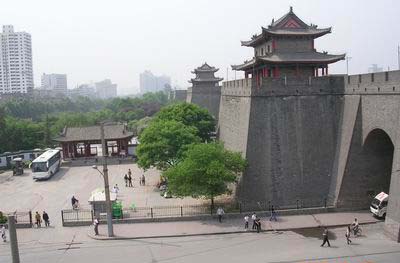
Jane Chen / Shanghai Daily news
After rushing to complete the last workday before the May 1 holiday, I flew
onto the train westward to start a long-awaited tour to China's two most famous
ancient capital cities, Xi'an and Luoyang, in the hopes of exploring the
birthplaces of the country's long history and civilization.
Though the train was scheduled to reach Xi'an at around 8.40 a.m. the next
morning, I was unable to wait. I got up at dawn and was soon enchanted by the
sight of caves scattered in the hills along the railway.
These caves, reputedly cool in summer and warm in winter, once provided
traditionally comfortable housing for the local people in West China. Nowadays,
villagers seem to prefer life in concrete buildings, turning the caves to
alternative storehouses for crops and supplies.
When the roaring train finally arrived in Xi'an at 9 am, some half an hour
behind schedule, I jumped off and took a deep breath--only to find the air no
clearer than it is in Shanghai, my home.
The guide told me that the air quality in Xi'an might in fact be worse than
in Shanghai because of dense sand and dry climate.
In a favorable geographical location surrounded by water and hills, Xi'an,
capital of Shaanxi province, is at the heart of China's rooster-shaped
country.
Called Chang'an in ancient times, Xi'an had 13 dynasties such as Zhou, Qin,
Han and Tang place their capitals here during its 3,100-year history.
Because of this cultural and historical significance, the city has abundant
relics and sites, and has been given the title "Natural History Museum".
In Xi'an, the landmark Terra Cotta Warriors and Horses museum was of course
not to be missed. It was where I went first.
The museum is really large, as it took me some 15 minutes to walk from the
entrance to the three pits where the warriors and horses that had been excavated
are on display. The walk seemed reasonable, for it had prepared me well to
view the even bigger and more splendid archeological discovery, which is really
deserving of the title "the eighth major miracle of the world".
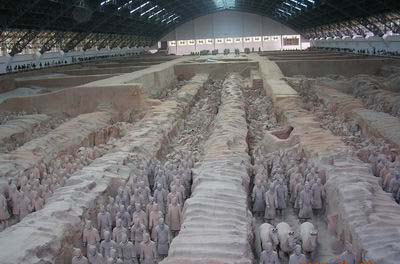
In the pits, life-size terracotta figures of warriors and horses are arranged
in battle formations. They are replicas of what the imperial guard looked like
over 2 000 years ago. Qin Shihuang, China's first emperor, believed that
this terracotta army would accompany him in his afterlife, so he made it a part
of his mausoleum.
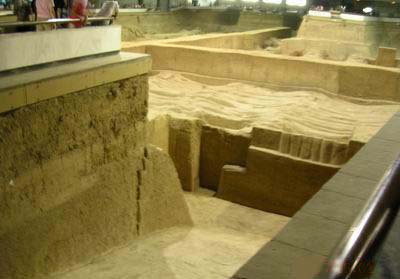
There are an estimated 500-odd pits guarding the emperor's tomb. So
far, only three have been uncovered and are on display. The digging is
still going on, but there are no massive excavations.
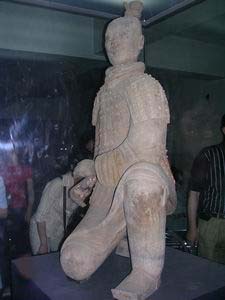
Before some broken figures, there are electric fans, brushes, paints, stools
and other tools. Obviously, the figures are still undergoing
restoration. Archeologists have to carefully stick together the broken
pottery pieces to restore the figures to their past grandeur.
Some parts in the pits are still uncovered. My guide said that
archeologists have to first excavate these discoveries before they are able to
finish fixing the previous figures. They are afraid that the gorgeous colors of
the pottery figures will be soon oxidized and fade. The warriors and
horses standing as complete figures at the front rows are now dusty gray.
They originally wore colorful armatures when they were first unearthed in
1975.
As I finish the tour, I think the 90-yuan ticket is really worth the visit. I
saw pottery soldiers, horses, chariots, and weapons uncovered from these
pits. Qin's army is believed to have been the world's most advanced at
that time.
Before my visit, I had heard that one of the peasants who had first
discovered the site when digging a well in 1974 would be sitting in the
museum everyday to sign books for visitors. But I did not see him.
He may also have been on a Labor's Day vacation.
Next stop was the mausoleum of Emperor Qin Shihuang, a 30-minute bus ride
away.
The tomb is not yet excavated and no one has ever seen inside. What the
real tomb must be like still remains a mystery.
Historians say the tomb's builders were killed shortly after the emperor was
entombed and legend has it that numerous designs of hidden weapons and machinery
were installed inside the tomb to keep offenders or robbers away.
Because of that, the underground palace I was shown is in fact only a model
based on history books.
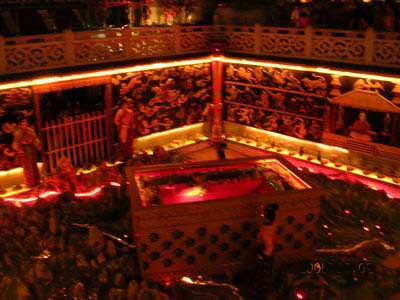
The underground space is dark, lit by candles. Qin Shihuang is said to have
wanted these candles because he hoped his afterlife underground could be as
bright and supreme as before.
Rows of figures in images of officials and servants are standing around
a coffin in the center of the underground space. The coffin must hold a
figure supposed to be Qin Shihuang. I stared onto the figure, but could
not see it very clearly.
Home to capitals of China's 13 dynasties, Xi'an is a best place not only for
Qinshihuang, but for all her emperors and empresses to rest. The tombs of
the subsequent rulers, particularly the prime Tang Dynasty emperors--some 1,000
years after Qin--are also eye opening.
Because of my tight travel schedule, I was advised to visit the Qianling
Mausoleum. It is the most typical and best preserved of all the 18 Tang
mausoleums. Although it is a joint tomb of the third Tang emperor Gaozong
(Li Zhi) and his queen Wu Zetian, it is usually described as Wu's tomb. she was
the only empress in China's history.
Curiosity and admiration for Empress Wu had brought me here.
Once my feet had set on the ground of the mausoleum, I was so excited by the
huge spaces around the tomb.

I had hoped to climb up the hill above the tomb, but my guide said the
sight atop the tomb may not be better than views along the long path leading to
the tomb.
Along the two sides of the path leading to the
mausoleum, stand some powerful stone statues. Most of them are caved in
images of Tang high-ranking officials, bowing piously to the rulers with planks
in their hands. Others are stone lions, China's image of imperial power. The
statues represent the extraordinary achievements of the sculptural arts of the
Tang Dynasty.
At the end of the path there is a stele called the blank Tablet. The
tablet, which should have recorded the achievements of the past rulers, carries
no single word. It was a condition of Wu's will.
While some say the empress was wise to leave the evaluations of her
achievements and errors to later generations, others speculate that the empress
is implying that her achievements were so grand that the stele is not large
enough to record them.
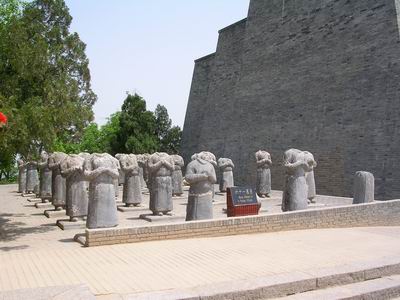
Beyond the tablet there are 61 stone figures of foreign guests, showing the
Tang's close relationship with foreign countries. Most of the figures have
had their heads defaced--maybe because of the long times. I stood behind
one figure, to have my picture with my head resting on its shoulders, making a
union of the modern and ancient times.
Leaving the Tang tombs, I returned to downtown Xi'an. The city is surrounded
by a Ming Dynasty City Wall, the most complete ancient city wall that has
survived in China.
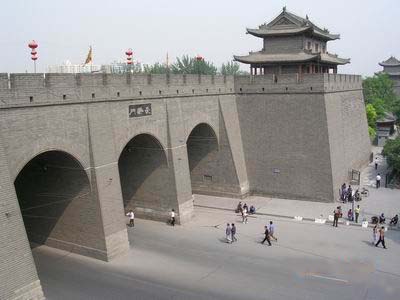
After hiking up 70 steps upstairs at the eastern Changle (meaning eternal
joy) Gate, one of the four along the wall, I climbed up to the wall to have an
view of the ancient capital city.
Overlooking the city from the battlements, I observed the people in modern
vehicles like bikes, buses and sedans passing through a gate that is
over-600-year-old.
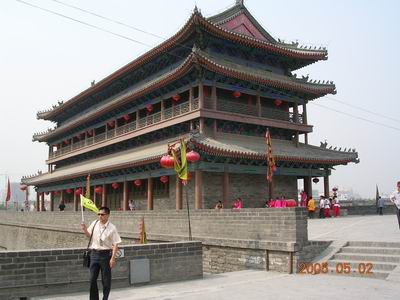
Displays of the ancient wood weapons and military facilities on the wall had
me imagine the old days when the city wall was used as one of the world's
biggest ancient military defense systems.
"How time has flown," I can't help but sigh.
If I had more time, I would have rented a bicycle or boarded a sightseeing
car to ride on the wall.
Xi'an's snacks should not be missed.
Before I concluded the trip there, I spent the last few hours in
restaurants to satisfy my taste buds with the most famous two snacks: Jiaozi
(dumplings) and Yang Rou Pao Mo (bun soaked in lamb soup).
At the Jiaozi banquet, I was served 20 Jiaozis with various fillings, ranging
from fresh vegetables to pork, chicken, beef, lamb and rice as well as a set of
cold dishes. The price was high, however. It cost me 80 yuan.
Yang Rou Pao Mo is cheaper--50 yuan, but no less delicious. The soup,
cooked with fresh lamb and dressed with plenty of spices, is most attractive to
me, while the bun in it is just ok. Buns are a staple food in northern
China. It's too easy for them to fill me up.
(more)



